On the river in Minneapolis
The energy first created by a waterfall has returned to this Mill City entertainment district.
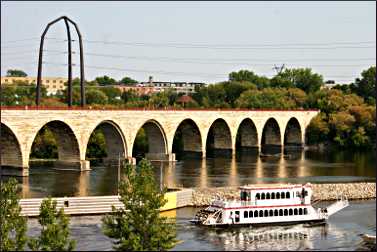
© Beth Gauper
The Falls of St. Anthony wasn't a very tall waterfall.
But it was broad and thundering, and the only major drop on the Mississippi.
More importantly, it got good PR from two best-selling travel guides, Father Louis Hennepin's 1683 "Description de la Louisiane" and Jonathan Carver's 1778 "Travels through the Interior Parts of North-America," both of which exaggerated its height.
Other explorers came, and in the 1820s ordinary tourists followed the first steamboats up the Mississippi, where they admired the falls, gawked at the Dakota living in nearby tepees and dined on such Wild West delicacies as buffalo, elk and sturgeon.
But even then, early entrepreneurs were laying plans to harness the power of the falls. By the 1870s, stone mills crowded the falls.
In 1880, Minneapolis took the flour-milling crown from St. Louis. Its Washburn "A" mill, the largest and most advanced in the world, could produce nearly 2 million pounds of flour a day.
In 1883, railroad tycoon James J. Hill built the gracefully curving Stone Arch Bridge, which brought wheat from the Red River Valley right to the doors of the flour mills.
The industry began to decline after World War I, and Minneapolis was supplanted as the nation's largest producer of flour by Buffalo, N.Y.
By the 1960s, the riverbanks and Nicollet Island were shabby and neglected.
Minneapolis was more enthralled by its new, pedestrian-friendly Nicollet Mall, which stretched away from the river, and then by the modern buildings along it: the blue-glass IDS tower, which became the city's tallest building in 1973, and Orchestra Hall, opened in 1974 at the mall's far end.
But the river banks began to come back in the 1980s. The restored brick storefronts of St. Anthony Main led the river renaissance. Although the shops have disappeared, its cinema, restaurants and walking paths still are a magnet.
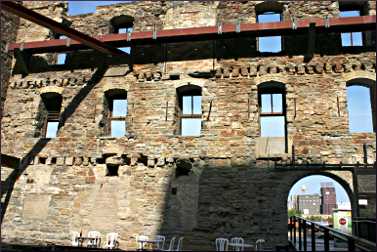
© Beth Gauper
An 1887 trestle bridge leads to Nicollet Island, where the limestone Nicollet Island Inn, built in 1893 as the Island Door and Sash Co., was refurbished and opened in 1982 with a glass-lined restaurant and bar.
On one end of the 48-acre island is a cavernous pavilion, once an 1893 steam plant.
On the other end of the island, houses have been restored into colorful showplaces, from a 1886 purple Queen Anne with teal trim to a yellow 1867 Greek Revival and the 1875 limestone Grove Street Flats, now condos.
A shady cobblestone pathway, lined by cottonwoods planted by a pioneer entrepreneur, follows the river from Nicollet Island to Water Power Park, tiny Father Hennepin Park and the Stone Arch Bridge.
Once slated for demolition, the bridge is one of the most beloved spots in the city. Open only to pedestrians, bicyclists and trolleys, it provides an unparalleled view of the falls and both sides of the river, and plaques explain milling history.
The west side of the river was developed more recently. In 1991, a fire nearly destroyed the Washburn A Mill, but the ruins became part of Mill City Museum.
Run by the Minnesota Historical Society, it features the eight-story Flour Tower, milling exhibits and baking demonstrations. On weekends, guides lead riverfront walking tours and costumed History Players make appearances as historical figures.
Next door, the cantilevered lobby of the Guthrie Theater stretches across West River Parkway. The striking building opened in 2006, and its unusual interior is filled with gawkers both night and day.
From Mill Ruins Park, it's a pleasant walk or bicycle ride up riverside paths to the Hennepin Avenue suspension bridge.
It's an unusually elegant span for such a short stretch, but it's an important spot: The first-ever bridge over the Mississippi was built here in 1855.
The path continues up the west side of the river to the Plymouth Avenue bridge and across to Boom Island Park. From there, a tiny 1901 trestle bridge crosses the channel back to Nicollet Island.
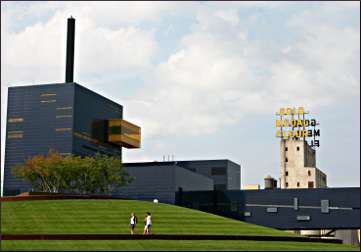
© Beth Gauper
One of the liveliest neighborhoods in Minneapolis is just across the channel and beyond the 1857 Lady of Lourdes Church, whose steeple is a Minneapolis landmark.
Once a tired-looking neighborhood of Eastern European émigrés, many of whom had moved on by the 1980s, northeast Hennepin Avenue now is lined by boutiques, cafes, coffeehouses and nightclubs.
New condos and townhouses have gone up, drawing affluent empty-nesters from the suburbs.
But its heritage lives on at Kramarczuk's, where stout matrons dish up borscht and pierogies, and whose aromatic sausage counter has been supplying homesick émigrés since 1954.
From any sidewalk, the skyscrapers of downtown Minneapolis can be seen, pointing to the sterile fate this little neighborhood escaped.
Today, this east-side stretch is called the Mississippi Mile. But it may as well be called the miracle mile.
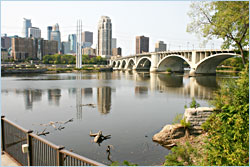
© Beth Gauper
Trip Tips: Riverfront Minneapolis
Getting there: The downtown side of the river is a four-block walk from the Downtown East (Vikings stadium) stop of the Blue and Green light-rail lines.
Annual events: Mid-May, Art-A-Whirl studio and gallery tour along Marshall Street and nearby in Northeast Minneapolis. Mid-June, Stone Arch Bridge Festival. July 4, Minneapolis Red White and Boom on the riverfront, with music and fireworks. Late July, Aquatennial and fireworks show.
Free summer concerts: Minneapolis Parks puts on free concerts in Father Hennepin Bluffs Park, on the north end of the Stone Arch Bridge.
Touring: It's a very pleasant 3½-mile loop by foot, bicycle or in-line skates from the Stone Arch Bridge to the Plymouth Bridge, through Boom and Nicollet islands.
For more, see Biking in Minneapolis and Great hikes in Minneapolis.
Walking tours: Mill City Museum gives riverfront walking tours. The fee includes museum admission.
Segway tours: Three-hour Magical History Tours on a Segway start at St. Anthony Main and cover five to seven miles. They're given April through October.
Cruise excursion: The Minneapolis Queen paddlewheeler takes passengers on narrated cruises on the river below the locks. It docks at Bohemian Flats Park, between the University of Minnesota East Bank and West Bank campuses.
Mill City Museum: Attractions include the Flour Tower, History Player appearances, Dust Explosion demos and Kevin Kling's "Minneapolis in 19 Minutes Flat" film. Admission is $12, $6 children 6-17. It's open Tuesday-Sunday.
Guthrie Theater: Plays are performed on three stages. The theater also offers backstage, architecture and costume tours.
Dining (east side of river): In the Guthrie, Ovation on Level Five is a French restaurant open to the public as well as theater-goers.
Next to the Guthrie, the Mill City Farmers Market is held Saturday mornings and is a good source of fresh treats and handicrafts.
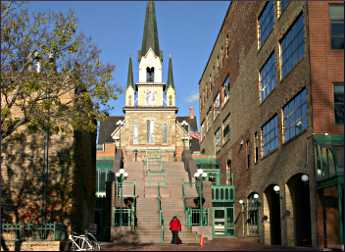
© Beth Gauper
Dining (west side of river): Along Main Street, the Aster Cafe serves salads, sandwiches, beer and wine and hosts live music most nights. Jefe Urban Hacienda offers a happy hour and patio.
Pivo Riverplace Restaurant & Taproom has a dog-friendly and smoke-free covered patio overlooking the river and will pack you a box lunch with two hours' notice.
On University Avenue, two blocks from Father Hennepin Park, Alma is one of the most sophisticated restaurants in Minneapolis.
A block up from the Hennepin Bridge, Kramarczuk's serves Eastern European comfort food. For Neapolitan-style pizza, there's Punch.
Surdyk's has an excellent deli; buy picnic fare and eat it on Nicollet Island.
There's also a Chipotle. Two blocks farther, Gardens of Salonica serves fine Greek food in a casual setting.
Water-ski shows: On the west side of the river, between the Plymouth and Broadway bridges, the Twin Cities River Rats put on free water-ski shows on Thursday evenings from June to Labor Day.
Accommodations: The limestone Nicollet Island Inn, built in 1893 as the Island Door and Sash Co., is in the middle of it all. It has 24 individually decorated rooms, all with views and some with whirlpool; ask about packages.
Alma offers seven rooms above the restaurant, with breakfast included.
The modern Aloft Minneapolis and the Canopy by Hilton in a 1904 former manufacturing building are the closest hotels to the Guthrie and can be very good values. The Canopy is next to a Trader Joe's.